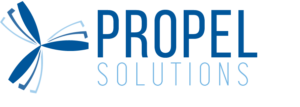Propel Solutions has led many system implementations over the years. Unfailing, there is one insight that continues to pop up no matter what type of business or industry we’re working with: what a client thinks they need at the beginning of a project is often vastly different to what they realize they require at the end.
In particular, the trend of thinking a new system will solve all organizational woes is something we have seen gaining popularity. Organizations may hear of “the best system for accounts payable”, and they expend the capital to purchase it due to the word on the street being it will fix your problems. Due to this, the results are lackluster and you may end up realizing that you are still experiencing some of the same problems you had before. As a result, this causes a constant cycle of changing systems frequently.
It is crucial to take time at the beginning stages of a project to fully identify the issues to be solved by the new system. Consequently, you will avoid costly project redirections that take time away from you and take profits away from your business. The next question is, how do you fully identify your core needs?
- Identify the processes you currently have in place and map them out. It is also helpful at this stage to critique the process maps with your staff and other internal groups. That way, you create engagement among your employees (key for change management), as well as include a variety of perspectives and job areas.
- Identify areas where technology would help reduce manual effort and administrative tasks. Part of this can be done through process map critiquing, but it is also useful to conduct interviews with key users and their managers.
- Identify limitations with the current system in use. Some of this information will be ascertained while completing the previous steps, but conducting observations of users while they engage with the system during their regular work will also help identify important limitations.
Once Steps 1-3 have been completed, you are able to determine what issues the new system will need to address. This is where the tricky part comes in, because the system implementation team has to expend a lot of effort to guide the organization forward. In Propel’s experience this is the time where organizations may realize the issues they are facing are not system related at all, but are process related.
Propel’s recommendations to clients over the years has been to stop trying to find a system that sounds like it will solve all of their problems. Instead, focus on identifying what the problem is. Many times, making small changes in your work processes can actually allow for the current system to be the better choice for the organization. A specific example that comes to mind was a past client who used SAP. This particular client was looking for a tracking system their collectors could use that would help them collect on past due invoices within SAP. Unknown to them, SAP did indeed offer tracking functionality. During Propel’s engagement with this client, we found a unique way to use SAP to accomplish what the collectors wanted to do by enabling a module within the system the organization was already paying for. The client was hesitant at first, because it had its heart set on a new system specifically designed for tracking. Knowing a new system would only generate additional issues for an internal process which was screaming for improvement, Propel facilitated the creation of new processes to align with the existing functionality built into SAP. As a result, the organization was sold on leveraging the existing system. In the end we trained close to 200 collectors at the organization on how to best utilize the current technology in place by making small changes to their processes. The project ended up being a huge success and the organization implemented the same changes to other headquarters globally.
In terms of system, new does not necessarily mean better. It’s best to look at your current processes first before you invest in a new technology solution. The results may surprise you.








